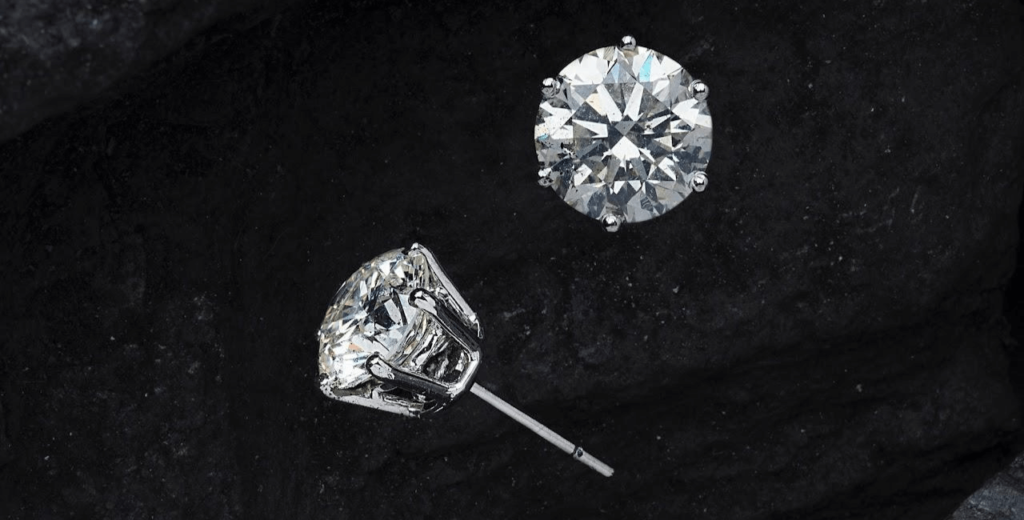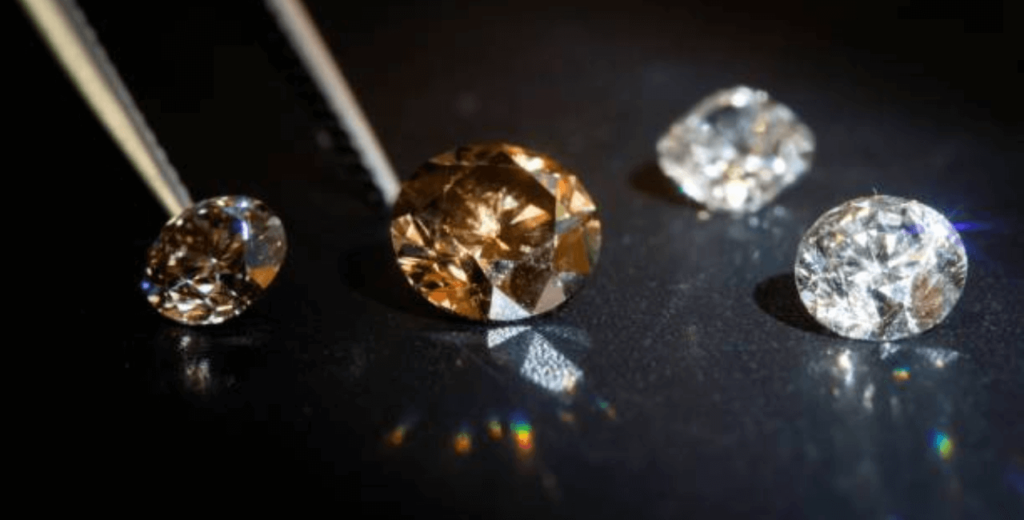Compared to natural diamonds, lab-grown diamonds are manufactured in a lab using advanced technological tools. You are probably wondering if you can tell the difference between the two.
The short answer is “No.” You cannot tell the difference between a lab-grown diamond and a natural diamond with the naked eye. This is because they possess the same chemical and optical properties as the mined diamonds.
You are about to shop for diamond jewelry for yourself, or you want to propose to your partner with a diamond engagement ring, but you have no expertise in diamonds. Fake diamond jewelry abounds in the market, and you are left wondering if lab-grown diamonds are synonymous with these fake diamonds?
Perhaps your mission is to make a statement with this buy, and it sounds scary that you may spend a large chunk of your savings on this, only to discover that it’s fake. Even scarier if it is something you want to give someone.
So before you make that big purchase, read this article to find out if lab-grown diamonds are real, the differences between lab-grown and natural diamonds, and how you can distinguish between natural and lab-grown diamonds.
Are man-made, lab-grown diamonds real?

Lab-grown diamonds are, without a doubt, real diamonds, just like mined diamonds. They have identical chemical, physical and optical properties to natural diamonds.
The artificial diamonds are made the same way the mined diamonds are formed under intense heat and pressure. But the lab-grown diamonds are manufactured with cutting-edge technology. This process results in diamonds that exhibit the same qualities as a mined diamond.
Regarding durability, lab-created diamonds are made of carbon, just like natural diamonds, and carbon is the hardest material on earth. Thus, they will be tough to chip like their natural counterparts.
What are the differences between lab-grown diamonds and natural diamonds?
The differences between lab-grown and natural diamonds are their origin, presence of nitrogen, duration of the production process, prices, resale value, environmental sustainability, and ethical means of production.Origin
When it comes to their origin, natural diamonds are formed by nature deep within the earth’s crust under high temperature and pressure, while lab-grown diamonds are created in the same conditions but in a lab setting.
They are created with a machine using either of the two methods: High-Pressure High Temperature(HPHT) System or the Chemical Vapor Deposition (CVD).
The High-Pressure High-Temperature process replicates the earth’s procedure of forming a diamond in high-pressure and high-temperature conditions. This process involves using a small diamond seed crystal and placing it into a natural graphite carbon.
It will then be exposed to 1,500C temperature and crushed under a pressure of about a 1.5 million pounds per square in a large machine. This condition will make the graphite turn into diamonds.
The Chemical Vapor Deposition(CVD) method is achieved using a seed crystal and placing it in a chamber. A carbon-rich gas is then filled in the chamber and heated to about 800C. This condition will lead the seed to grow, and the carbon gases will start sticking to the seed, creating a square-shaped diamond crystal.
Therefore, their origin is the main difference between lab-grown diamonds and natural diamonds; while one is artificial, the other is natural.
Presence of nitrogen
A tiny chemical difference between the two is that natural diamonds possess a small amount of nitrogen that is not visible to the naked eye, but this property is absent in lab-grown diamonds.
However, the Gemological Institute of America(GIA) has discovered a CVD-grown diamond with aggregated nitrogen impurities. But this can only be identified by gemologists with the right tools.
Duration of the production process
Many studies have reported that natural diamonds were formed about 3 billion years ago, while growing diamonds in a lab takes less than a month.
Price
Due to their rarity, natural diamonds are more expensive than lab-grown diamonds. Lab-grown diamonds cost about 30% less compared to natural diamonds, but you’re getting the same quality at a cheaper rate with lab-grown diamonds.
Natural diamonds are costlier because they are limited in supply and take billions of years to form.
Resale value
In terms of resale value, the natural diamond has a higher resale value compared to the lab-created diamond. Because they are typically produced in a lab in large numbers, there is no cap to the supply, so they typically have a lower resale value.
However, only very rare, high-weight and high-quality mined diamonds can actually be resold at the same or a higher price. But the moment we buy a diamond, it loses part of its retail value. This is because we pay for all the markups of the supply chain on the stone, while a similar stone is easily available directly from the wholesalers for less money.
The true value of a diamond comes down to the actual legacy it leaves as a precious and unique object. A lab-grown diamond is the new standard for responsible luxury. You can pass it down to your loved ones, making them proud of an ethical and sustainable approach.
Environmental sustainability
In contrast to growing diamonds in a lab, mining diamonds are not eco-friendly. The process destroys the ecosystem and can cause environmental hazards such as erosion and deforestation.
Lab-grown diamonds, on the other hand, represent the triumph of a generation that respects the environment and cares for the future of humanity. By buying lab-grown diamonds, you invest in an industry that makes the world a better place.
Ethical means of production
Natural diamonds are mostly not ethically sourced compared to lab-grown diamonds.
The working conditions in most countries diamonds are mined are terrible, and extreme cases of child labor have been reported.
There are also reports of human rights abuses in the diamond mining industry, where diamonds are produced in war-torn zones to fund wars, usually referred to as blood diamonds
How can natural and lab-grown diamonds be distinguished from one another?
You can only distinguish the lab-grown diamond from the natural diamond in a gemological laboratory or using sophisticated equipment designated for it.
Because the differences between lab-grown and natural diamonds are not visible to the eyes and cannot be detected using traditional diamond detectors, they can only be identified at a gemological laboratory.
You can also spot it using equipment developed by the Gemological Institute of America(GIA) and other expert organizations.
The telltale factors

The presence and size of inclusion are part of their distinguishable quality, and these inclusions can affect their clarity. For the lab-grown diamond, the inclusions look like crystals and are remnants of the growth process, while natural diamonds have clusters of tiny inclusions that look cloudy.
In CVD diamonds, the inclusions have a graphitized appearance, while the HPHT diamonds have metallic inclusions.
However, the three categories can have similar-looking inclusions.
Also, both lab-grown diamonds possess the same qualities but have different growth mechanisms. Their formation and growth process affects the direction and shape of the diamond crystals.
This study on the morphology of diamond crystals has reported that their morphological features are based on the growth of dislocation, non-dislocation, normal, and block.
The natural diamond has a different growth morphology and shape than the others. According to the GIA, the shape of the natural diamond is Octahedron, and the growth occurs in eight different directions.
The High-Pressure High Temperature(HPHT) diamond has the shape of a cuboctahedron with 14 directions. In contrast, the Chemical Vapor Deposition(CVD) diamond has the shape of a cube and grows in 1 direction.
However, these shapes disappear after the diamonds undergo cutting and polishing and can only be identified by spotting fluorescence patterns from their specific growth process using the right tool.
Additionally, they can be distinguished through their certifications as most jewelers are responsible for declaring if the diamond is natural or lab-grown.
Conclusion
It is impossible to tell the differences between lab-grown diamonds and natural diamonds with the naked eye because they are not visible but can only be detected in a gemological laboratory or by using specialized equipment.
The differences between the two are based on their origin, presence of nitrogen, duration of production, prices, resale value, environmental sustainability, and production ethics.
The lab-grown diamond is a real diamond because it has the same optical and chemical properties as its natural counterpart. And just like the natural diamond, it is durable and can last forever.
If you want to purchase more ethically sourced lab-grown diamond jewelry of the highest quality, contact Etika Jewels today!

